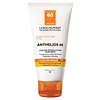What's inside
What's inside
 Key Ingredients
Key Ingredients

 Benefits
Benefits

 Concerns
Concerns

 Ingredients Side-by-side
Ingredients Side-by-side

Water
Skin ConditioningCyclohexasiloxane
EmollientGlycerin
HumectantCetyl Alcohol
EmollientButyrospermum Parkii Butter
Skin ConditioningHydrogenated Polyisobutene
EmollientGlyceryl Stearate
EmollientOctyldodecanol
EmollientPEG-40 Stearate
EmulsifyingMyristyl Myristate
EmollientTitanium Dioxide
Cosmetic ColorantIron Oxides
CI 77163
Cosmetic ColorantBixa Orellana Seed Oil
EmollientGuanosine
Skin ConditioningCyathea Medullaris Leaf Extract
Skin ConditioningZea Mays Starch
AbsorbentTocopherol
AntioxidantMica
Cosmetic ColorantHydrolyzed Linseed Extract
Skin ConditioningHydroxypropyl Starch Phosphate
Sodium Hydroxide
BufferingSodium Benzoate
MaskingHydrogenated Lecithin
EmulsifyingSodium Levulinate
Skin ConditioningPhenoxyethanol
PreservativeAdenosine
Skin ConditioningSchizandra Sphenanthera Fruit Extract
AntioxidantChlorphenesin
AntimicrobialPolysorbate 80
EmulsifyingMaltodextrin
AbsorbentPolyvinyl Alcohol
Helianthus Annuus Seed Oil
EmollientLimonene
PerfumingSynthetic Fluorphlogopite
Mannitol
HumectantBenzyl Alcohol
PerfumingTin Oxide
AbrasiveLinalool
PerfumingXanthan Gum
EmulsifyingCinnamic Acid
PerfumingIsohexadecane
EmollientIsobutane
Capryloyl Salicylic Acid
ExfoliatingCaprylyl Glycol
EmollientSorbitan Tristearate
EmulsifyingAcrylamide/Sodium Acryloyldimethyltaurate Copolymer
Emulsion StabilisingAcrylonitrile/Methyl Methacrylate/Vinylidene Chloride Copolymer
Sorbitan Oleate
EmulsifyingGeraniol
PerfumingDisodium EDTA
Citronellol
PerfumingCitric Acid
BufferingLevulinic Acid
PerfumingGlyceryl Caprylate
EmollientParfum
MaskingWater, Cyclohexasiloxane, Glycerin, Cetyl Alcohol, Butyrospermum Parkii Butter, Hydrogenated Polyisobutene, Glyceryl Stearate, Octyldodecanol, PEG-40 Stearate, Myristyl Myristate, Titanium Dioxide, Iron Oxides, CI 77163, Bixa Orellana Seed Oil, Guanosine, Cyathea Medullaris Leaf Extract, Zea Mays Starch, Tocopherol, Mica, Hydrolyzed Linseed Extract, Hydroxypropyl Starch Phosphate, Sodium Hydroxide, Sodium Benzoate, Hydrogenated Lecithin, Sodium Levulinate, Phenoxyethanol, Adenosine, Schizandra Sphenanthera Fruit Extract, Chlorphenesin, Polysorbate 80, Maltodextrin, Polyvinyl Alcohol, Helianthus Annuus Seed Oil, Limonene, Synthetic Fluorphlogopite, Mannitol, Benzyl Alcohol, Tin Oxide, Linalool, Xanthan Gum, Cinnamic Acid, Isohexadecane, Isobutane, Capryloyl Salicylic Acid, Caprylyl Glycol, Sorbitan Tristearate, Acrylamide/Sodium Acryloyldimethyltaurate Copolymer, Acrylonitrile/Methyl Methacrylate/Vinylidene Chloride Copolymer, Sorbitan Oleate, Geraniol, Disodium EDTA, Citronellol, Citric Acid, Levulinic Acid, Glyceryl Caprylate, Parfum
Butyl Methoxydibenzoylmethane 2.24%
UV AbsorberHomosalate 8%
Skin ConditioningEthylhexyl Salicylate 2.4%
UV AbsorberOctocrylene 4.48%
UV AbsorberBenzophenone-3 2.88%
UV AbsorberWater
Skin ConditioningAlcohol Denat.
AntimicrobialDimethicone
EmollientCyclopentasiloxane
EmollientAcrylates/Dimethicone Copolymer
Skin ConditioningPhenoxyethanol
PreservativePropylene Glycol
HumectantCaprylyl Glycol
EmollientSodium Polyacrylate
AbsorbentSilica
AbrasiveAcrylates/C10-30 Alkyl Acrylate Crosspolymer
Emulsion StabilisingDisodium EDTA
Tocopherol
AntioxidantMenthyl Lactate
MaskingDiethylhexyl Syringylidenemalonate
Skin ProtectingCassia Alata Leaf Extract
AstringentMaltodextrin
AbsorbentButyl Methoxydibenzoylmethane 2.24%, Homosalate 8%, Ethylhexyl Salicylate 2.4%, Octocrylene 4.48%, Benzophenone-3 2.88%, Water, Alcohol Denat., Dimethicone, Cyclopentasiloxane, Acrylates/Dimethicone Copolymer, Phenoxyethanol, Propylene Glycol, Caprylyl Glycol, Sodium Polyacrylate, Silica, Acrylates/C10-30 Alkyl Acrylate Crosspolymer, Disodium EDTA, Tocopherol, Menthyl Lactate, Diethylhexyl Syringylidenemalonate, Cassia Alata Leaf Extract, Maltodextrin
Ingredients Explained
These ingredients are found in both products.
Ingredients higher up in an ingredient list are typically present in a larger amount.
Caprylyl Glycol is a humectant and emollient, meaning it attracts and preserves moisture.
It is a common ingredient in many products, especially those designed to hydrate skin. The primary benefits are retaining moisture, skin softening, and promoting a healthy skin barrier.
Though Caprylyl Glycol is an alcohol derived from fatty acids, it is not the kind that can dry out skin.
This ingredient is also used as a preservative to extend the life of products. It has slight antimicrobial properties.
Learn more about Caprylyl GlycolDisodium EDTA plays a role in making products more stable by aiding other preservatives.
It is a chelating agent, meaning it neutralizes metal ions that may be found in a product.
Disodium EDTA is a salt of edetic acid and is found to be safe in cosmetic ingredients.
Learn more about Disodium EDTAMaltodextrin is a polysaccharide. It is derived from starch such as rice, corn, wheat, or potato starch.
In food, Maltodextrin is used to improve the texture and thicken a product. Due to its structure, it can help create a gel texture. As an emulsion stabilizer, it helps keep the ingredients in a product together.
As a polysaccharide, Maltodextrin has moisturizing properties. Polysaccharides are a type of carbohydrate. The top layer of skin uses polysaccharides to retain water, keeping the skin hydrated.
Maltodextrin is water soluble and has a sweet taste.
Learn more about MaltodextrinPhenoxyethanol is a preservative that has germicide, antimicrobial, and aromatic properties. Studies show that phenoxyethanol can prevent microbial growth. By itself, it has a scent that is similar to that of a rose.
It's often used in formulations along with Caprylyl Glycol to preserve the shelf life of products.
Tocopherol (also known as Vitamin E) is a common antioxidant used to help protect the skin from free-radicals and strengthen the skin barrier. It's also fat soluble - this means our skin is great at absorbing it.
Vitamin E also helps keep your natural skin lipids healthy. Your lipid skin barrier naturally consists of lipids, ceramides, and fatty acids. Vitamin E offers extra protection for your skin’s lipid barrier, keeping your skin healthy and nourished.
Another benefit is a bit of UV protection. Vitamin E helps reduce the damage caused by UVB rays. (It should not replace your sunscreen). Combining it with Vitamin C can decrease sunburned cells and hyperpigmentation after UV exposure.
You might have noticed Vitamin E + C often paired together. This is because it is great at stabilizing Vitamin C. Using the two together helps increase the effectiveness of both ingredients.
There are often claims that Vitamin E can reduce/prevent scarring, but these claims haven't been confirmed by scientific research.
Learn more about TocopherolWater. It's the most common cosmetic ingredient of all. You'll usually see it at the top of ingredient lists, meaning that it makes up the largest part of the product.
So why is it so popular? Water most often acts as a solvent - this means that it helps dissolve other ingredients into the formulation.
You'll also recognize water as that liquid we all need to stay alive. If you see this, drink a glass of water. Stay hydrated!
Learn more about Water